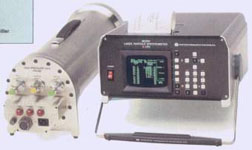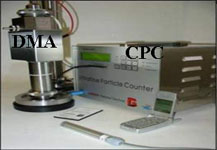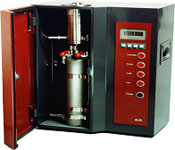
Instrumentation Optique.
With an Optical Instrumentation, the detection of particles is made by distribution of the light but the diffused intensity decreases with the diameter, these devices are thus less adapted for the small nanoparticles: more the particle is small more it is difficult to detect. These devices can measure agglomerates and aggregates. The grading distribution and the concentration are real time measured. Example of covered range: 80 nm - 1 µm (optical diameter).

Scanning Mobility Particle Sizer.
Scanning Mobility Particle Sizer consists of a DMA (“Differential Mobility Analyzer”) and a CPC (“Condensation Particle Counter”). The DMA sorts out particles by differentiating their electric mobility. A system of collection selects particles by size. They are then counted by distribution of light by the CPC. Covered range: 2.5 - 1000 nm (diameter of electric mobility).

Fast Mobility Particle Sizer.
Fast Mobility Particle Sizer With this technique, real-time measure of distribution is made. Particles are electrically loaded with by means of a charger Coronna. Covered range: 5.6 nm - 560 nm (electric mobility diameter).

Electrical Low Pressure Impactor.
Electrical Low Pressure Impactor
Particles are loaded, then sorted out by size inside an impactor (by inertia). This instrumentation offers an off-line particle characterization with MEB, ICPMS… Covered range: 7 nm - 10 µm (aerodynamic diameter). Real time distribution.


